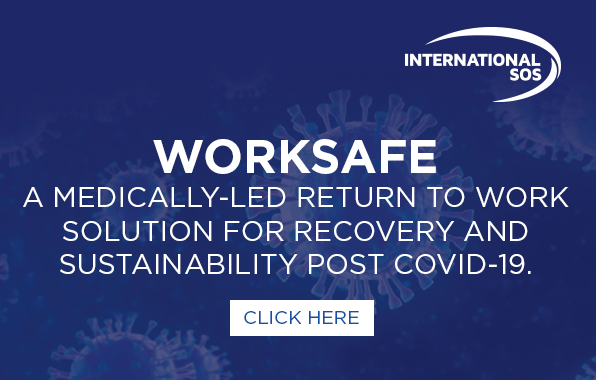
International SOS is consistently growing and developing its mining footprint around the world, from exploration phase, through operational phases, including construction, operations and mine closure.
As one of the leaders in mitigating Medical and Security risks in mining, International SOS is also recognized as a key partner for accurate and timely information to clients in the sector.
In the return to a ‘new normal’, the working environment has become the focus for many organisations as lockdown measures relax, and it is imperative for businesses to make sure that the transition is safe and sustainable. In many locations, it is also evident that court cases may ensue if businesses do not implement the correct mitigation measures.
Dr Mark Parrish, Regional Medical Director, Northern Europe at International SOS, said, “Businesses are facing unprecedented challenges on multiple fronts. As part of ensuring the sustainability of operations, organisations must protect the safety and wellbeing of their employees throughout the return to work. Anything less could result in a backwards step in the successful return to operations, in the fight against COVID-19 and could even result in prosecutions.”
Dr Parrish added that, “While no business can guarantee preventing the spread of infection, vital precautionary steps will minimise risks, fulfil duty of responsibilities carefully and promote workforce resilience. Whatever the circumstances, whether an office, a factory, a retail outlet or even out on an oil rig, preparation and ongoing actionable insights drawing from the most up to date information are a must to detect threats, mitigate risks and provide swift treatment if needed. Taking into account governmental guidelines and assessing what is necessary for a particular workforce, both from a logistical perspective and personal one, to return safely will take great measures for many businesses. The organisations implementing the correct measures will have the greatest chance of success in resuming safe working operations.”
International SOS highlights eight steps for returning to WORKSAFE operations:
Workspace environment: consider screening, zoning, barriers, cleaning protocols, ventilation, access, and the provision of PPE & IT equipment where needed.
Operations: isolation, essential hygiene, health and medical measures; health questionnaires and providing physical and mental health support.
Regulations: policies monitored, in line with Government regulations and ensuring medical needs are fully covered including Occupational Health and Safety and travel.
Knowledge: understanding of the latest quarantine and transport requirements and medical certificates. Ability to do contact tracing and quarantining in a timely manner. Privacy considerations are also a must.
Social distancing: limiting numbers to the workplace, space planning, staggering working hours and days, including split team shifts, continued flexible and remote working.
Alert: setup automated methods to be alerted to emerging threats: new local clusters, second waves, and changing security risks e.g. civil unrest.
Fortify: establish partnerships with apolitical infectious disease experts, providing accurate and timely advice.
Empowering employees: communication and training is key in creating workplace arrangements and policies. Engaging leadership and role modelling are critical. Effective complaint practices.
Whether preparing for or are amidst the restart of regular activity, the key priorities of businesses are to:
- Protect people: This entails having constructive protocols and procedures to efficiently bring employees back to the workplace, and to ensure that the working arrangement is safe and conducive for all.
- Protect business, with a planned and effective return to operations so as to swiftly ramp up activity and prevent against loss of productivity and costs.
- Comply with applicable laws and regulations ensuring that the procedures you develop and implement abide by the guidelines and standards outlined by local governing authorities and trade organisations.
Once infected by COVID-19, some individuals develop clear symptoms, while others do not. The latter are thus unaware of their health status. As such, truly non-infected individuals are at a higher risk of being infected in the workplace.
The return to operations in the ‘new normal’ of daily activity entails significant changes in health-related monitoring and behavior. The need to employ health services and measures that can effectively detect threats, mitigate risks and provide treatment is vital. Whether managing a single site, multiple sites, a Junior or a major, the WorkSafe Solution is designed to assist in the development of sustainable protocols, assisting businesses with a safe return to business activities, and to support long-term organisational continuity. If you would like to have a discussion about the WorkSafe solution, kindly fill in the form here. For more information on the COVID-19 resources and solutions we offer, visit our‘Return to Operations’ webpage.
Content contributed by International SOS
